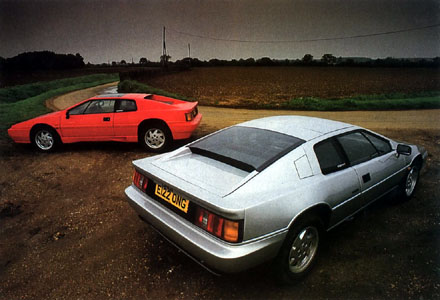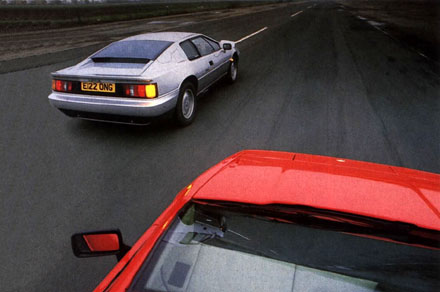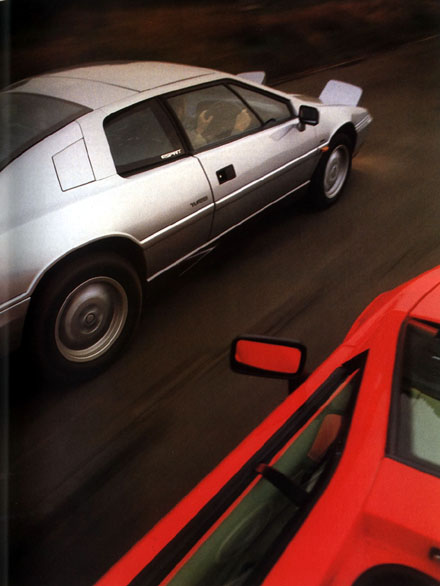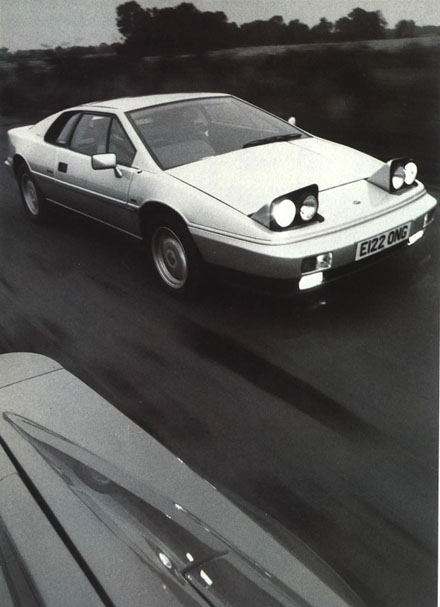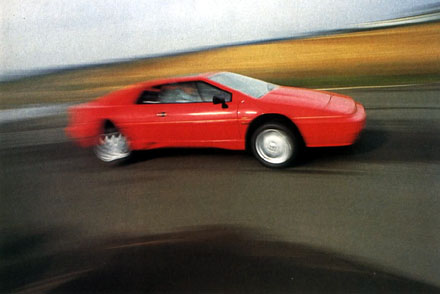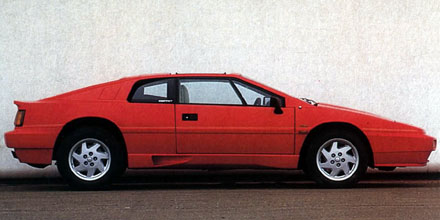
Click to enlarge
Esprit The Sleek
Autocar magazine October 1987
Lotus’ new Esprit, launched this week, replaces sharp-edged aggression with a softer, smoother look that gives the model a new lease of life as Britain’s only mid-engined supercar . . . and the Norfolk company’s best bet yet to take on the dominant might of Porsche and Ferrari. Report Bob Murray, photography Jim Forest.
“You’d pick it for a Lotus,” I said, as the 1987 Esprit wheeled around a slip road and our on to the aircraft runway that passes for the Lotus’s test track. It was the right size for a Lotus – low and wide – was plainly mid engine, had a vaguely familiar glass house, trademark pop-up head lights and a suggestion, albeit subtle, of the flying wedge profile that made the original Esprit one of the most distinctive sights on the road. I had said the right thing. The Lotus people around me looked happy. It’s easy to understand the problem that faced Lotus Designers, led by Colin Spooner, in restyling the Esprit. One the one hand they were not about to give away everything that the old model’s so familiar shape has come to stand for, but on the other they had to change what was, in the late ‘80’s, an unfortunately overt statement of aggression. The shape had to become softer, more rounded and more sophisticated, but it had to sit on the same track and wheelbase dimensions. It had to offer solutions, or at least improvements , to long standing Esprit problems. And it had to be done quickly; drawing board to launch had taken no more than 15 months.
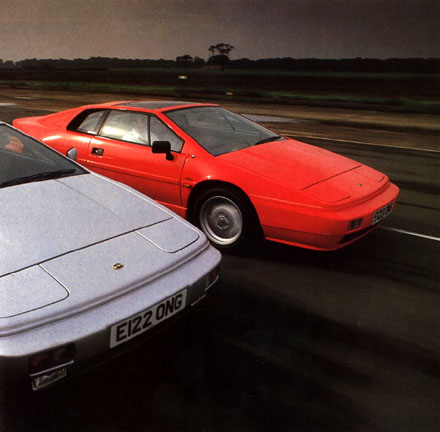
Staggering to think now, sitting back and looking at the car in
photographs or in the flesh, that the Esprit and Esprit Turbo’s
new suit of clothes varies from the razor-lined original by no more
than half an inch in any place. And yet put the cars side by side
and they appear fundamentally different, easily a reflection of
the 12 years that separate them, but also a reflection of the ever
increasing maturity at Hethel. Here is a new car with the style
to give Britain’s only mid-engined supercar strong new credentials
as it entres its second decade of Porsche and Ferrari chasing.
As before, the flagship Turbo provides the figures to tempt any
lover of the German or Italian marques. The bottom line here is
claimed 152mph and 0 – 60 in 5.3 seconds – slightly
up on the older model – and a price tag of £3000 more,
as £28,900 plus options. The increases are similar for the
normally aspirated version, which claims 138mph, 0 – 60 in
6.5 seconds and has a price tag of £22,950. Both cars go on
sale soon after the Motorfair.
The
performance per pound ratio takes on a new importance in a car that
looks this fresh and, it must be said, so much more “expensive”
than the older model. The body is all new, and the design for it
was all in-house – hence the Lotus Design badges where once
Giugiaro’s moniker sat. Top and bottom halves of the body
shell are constructed of the same composite material, with some
Kevlat reinforcement, but instead of being hand-laid as before are
now moulded by Lotus’ vacuum-assisted resin injection, or
VARI process. The body is bolted directly to the familiar backbone
chassis for torsional rigidity that is claimed to be improved, to
the benefit of both rough road refinement and handling.
The suspension mix of front double wishbones and rear upper and
lower transverse links continues unaltered, as does the rack and
pinion steering. A change from the Citroen to Renault GTA transaxle
results in slightly taller gearing – and a very different
feeling gear change – and a switch at the rear from inboard
o outboard disc brakes. Revisions to turbocharger, wiring, exhaust
system and radiator make up the few mechanical alterations.
On the outside the new shape’s effectiveness is both the result
of a rounding off of all key lines and an attention to detail that
brings neat new solutions to previous problem areas. The wiper and
headlight mechanisms score here, while flush-fitting fuel flaps
and, in place of the old module’s tacked-on air scoop by the
C-pillar, a simple intake created by curving inwards the rear windows,
provide a much more pleasing look. Front and rear bumper sections
are now knock – resistant mouldings. All the glass is new,
including the windscreen, which features a slightly increased curvature.
Door frames are now steel with double seals, a much needed change
to reduce wind noise. The tilt / remove roof panel is Nomex honeycomb
or as an option, tinted glass. Wheels are to a new Lotus design
and made in Italy; Turbo or normally aspirated models wear the same
size tyres, Goodyear NCTs on the test cars, of 195/60/VR15 front
and 235/60 rear.
The Turbo is distinguished by its different front section with fog-lights
and changed air intake, a different rear panel, one – colour
body with black mirrors, and, visually the most dramatic difference,
an additional glass panel fared in between the rear buttresses,
which remain open – for a “tunnel back” look,
according to Lotus – on the normally aspirated car. It’s
a similar devise to that used by the Maserati to differentiate Merak
from Bora. Common to either model are the door handles. They are
from the Austin Maxi. On such an otherwise thoroughly restyled car
they represent an unworthy link with a kit car past.
On the inside the feel is much the same as before, with two low
set seats separated by the wide and high central backbone, splitting
the cabin into two halves. These is much that is new, though, most
of it aimed at curing the Esprit’s bogies of lacking cabin
and footwell room for the tall, poor ventilation and visibility
and what was a rather old hat instrument layout with its spread
of badly reflecting, partly hidden white on black Smith dials.
Instruments are now VDO but they’re still white on black,
they still reflect and the tacho, especially, is still masked by
the steering wheel. This is a shame since the binnacle is newly
designed. It’s of roughly the same shape as before, with fingertip
reach switch panels at either end of the pod, but features new,
and better, push-push controls and more warning lights including
a check function. There’s still a comprehensive range of dials
– from left, volts, oil pressure, tacho, speedo, water temp
and fuel contents. The Turbo gets a small boost gauge set between
the tacho and speedo; its absence on the normally aspirated car
gives a rather unfinished look.
There’s
still a bit of bent wire under the dash to release the front boot
– full of grake booster, neatly packaged relays and fuses
and spare wheel, and as before without additional luggage space.
The electric mirrors / windows are new, and well sited and illuminated
at night. With the Turbo’s two-tone leather trim across seats
and door panels the cabin has a convincing air of class.
But there are lost opportunities too. The ventilation system benefits
from a new, supposedly quieter fan but it’s still to noisy
and of the Driver’s “face” level vents one faces
your knee and the other the bottom of the instrument binnacle. And
the Esprit’s cabin is still on the tight side: a lovely, all-enveloping
cocoon if you fit – which means someone no more than average
height – but not the place for the long limbs, though decent
clearance between the thick-rimmed three-spoke wheel and seat cushion
means the tall are not excluded: like Lotus Boss Mike Kimberely
I’m 6ft 5 inches and just ok behind the wheel.
You climb down into the Esprit over a wide sill; entry is not the
easiest, but once in, the seat, a new design, is quickly comfortable:
quite soft and well shaped, with good lumbar support and under-thigh
padding. The steering wheel and stubby gear lever are ideally placed,
and the wider spacing of the pedals is good news. The fly-off handbrake
is mounted on the outer sill, quite a long way forward on the Driver’s
and can be a stretch to reach.
The 172bhp normally aspirated engine fires quickly and settles to
an even, if boomy, idle. Response and power are well up to expectations
and smoothness and flexibility to the levels we have come to expect
of the Lotus twin cam in its latest high-compression guise. But
in this car, the first pre-production example, the boomy idle goes
on to become a tiring low speed boom, in great contrast to the Turbo,
which has it’s own assortment of sounds but lacks the basso
profundo when trundling. What is clear, in either models, is the
greatly reduced roar from outside, a result not just of those newly
installed double rubber seals but also, we suspect, of relocated
air outlets: cabin air is now exhausted through through vents in
the bottom of the doors. You now have to open the Driver’s
side window to get an ear full of the twin carbs’ characteristic
sucking when you crack open the throttle, and also, in the Turbo,
of the wastegate’s rather – too – prominent baying
on the overrun.
It matters little, for once underway in the Esprit Turbo, windows
closed, you are plainly in what is a very much better sealed cabin
than before. Other things remain the same: the handiness of all
the controls, the delightfully weighted and communicative steering,
the single minded ability through corners and the flexibility and
potency of the 215bhp turbocharged power-pack behind your back.
The new transaxle, chosen, says Lotus, both for economic reasons
and its ability to cope with the power more easily, is an unobtrusive
newcomer to the Esprit package: the clutch is just as gentle and
progressive as before, and even under provocation there’s
little sign of driveline snatch. In the Turbo at least, the slightly
taller gearing has no discernible effect on performance. Where the
new transaxle does make its presence felt is in the quality of the
gear change.
Lotus describes it as “low inertia” and indeed it is
lighter than before. Mike Kimberley and others at Lotus who have
driven the car, say they prefer the change, now cable rather than
rod operated. After my drive, however, I was unconvinced, the change
replaces the positive switch action of old with a less precise,
less mechanical feeling movement.
On the winding and bumpy Norfolk lanes the Turbo felt as supple
and agile as ever, flying through even tricky corners, with their
wrong camber and patches of wet leaves, with tremendous precision
and grip. The steering is still marvellous, the engine, for a blown
2.2 litre four cylinder, undoed with good torque and response throughout
its wide range, with a top end – say, 5000 – 7000 rpm
– potent enough to reinforce the claimed 0 – 60 times
and yet far too refined to be called brutal. Handling on public
roads is neutral: this Esprit Turbo was said to be running softer
than standard dampers, as an experiment, and suspension travel,
along with body roll, felt as though it could have been tied down
a little harder without spoiling the ride.
On the pot-holed and pitted test track, driving hard, it was quickly
plain that the claimed increase in torsional rigidity is no mere
fantasy: there is no trace of the old model’s body shake over
severely rough surfaces. On indifferent public roads or that rough
track the new car feels much more of a piece than before, not perhaps
the Porsche hewn – from - rock solidity but certainly more
solid feeling than any previous Lotus I’ve driven, and more
than a good number of monocoques. The feeling is heightened by the
cabin’s much improved sealing, and together these aspects
represents a significant step forward for the car.
Handling, braking – and what wonderful brakes they are –
steering and that special Esprit seat of the pants feel come together
on the track in spectacular style. Turn in is quick and accurate,
grip is excellent and traction, as the accelerator pedal goes back
down to the floor, the master of all but the greasiest surfaces.
The things are essentially as before honed to a new level –
Esprit Owners climbing abroad for the first time should not expect
big differences in the driving. Lotus says this is not a new car
and indeed it is not. In so many ways crucial was it didn’t
need to be. With the good bits retained and some – though
not unfortunately not all – of the weak areas improved, the
new Esprit represents a package that anyone in the supercar market
would be foolish to ignore.

